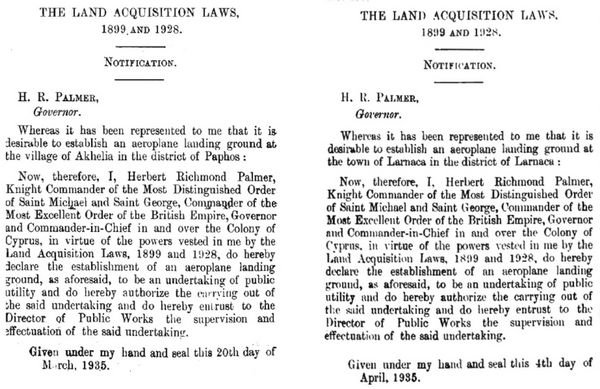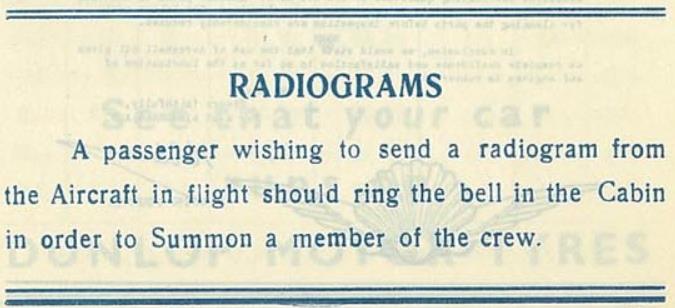The Early Days
Sir Ronald Storrs was Governor of Cyprus between November 1926 and October 1932 and, on taking office, was shocked to learn that no aeroplane or seaplane had arrived in Cyprus since the end of WW1.

Sir Ronald recognised the colony's potential as a tourist destination, along with the necessity of improving communications
In 1927 he began lobbying Imperial Airways to substitute Nicosia for Alexandria as one of their refuelling stops on their Eastern Route and established an emergency landing ground outside Nicosia.
Sir Ronald rapidly became the 'air' bore to the Colonial Office and the 'Cyprus' bore to the Air Ministry and Imperial Airways.
His lobbying and other plans came to very little but the rudimentary landing facilities outside Nicosia were improved slightly. Pilots were warned that although there was the luxury of a telephone at the airfield, the landing ground could only be used if notice of arrival was given in advance. Additionally, during very wet weather the airfield was liable to flooding and was frequently unusable.
The Cyprus Gazette dated 17th April 1930 reported on the success of an RAF inspection.

This inspection appears to have included a visit by two RAF aircraft from Palestine and Egypt on the 30th March 1930.

As can be sensed from the image above, this event caused great excitement

The RAF appear to have been very accommodating in giving good public access to these "marvellous flying machines"

The aircraft on the left is a Fairey III F from 14Sqn.......the one remaining squadron (with reconnaissance duties) based in Amman with detachments in Ramleh
The aircraft on the right is a Vickers Victoria from 216Sqn........a transport unit based at Heliopolis with duties throughout the Middle East
This model of aircraft was used to fly troop reinforcements to Cyprus in 1932
Images displayed by kind permission of the Severis Foundation
The use of Nicosia as a waypoint for Imperial Airways is somewhat uncertain. An extract from the Cyprus Gazette dated 16th October 1931 appears quite promising.

However, the history of Imperial Airways indicates that the service was operated using Short S17 Kent flying boats and that they landed at Limassol.
There is no evidence (as yet) that the aircraft flew over Nicosia and that letters were "dropped".


The above images show a Short Kent flying boat of Imperial Airways on the Sea of Galilee and the first airmail letter that arrived in Limassol on the 19th April 1932
One of the first visitors to Nicosia in early 1932 was a Sikorsky S-38 flying boat.
This 8-seater American aircraft was known as the "Explorer's Air Yacht" and just over 100 were built.
The owner of this particular aircraft (named "Silver Wings") was Margery Durant who conceived a plan to popularize private air travel by touring Europe, the Middle East and Africa by air.

This was Margery's second tour which lasted from December 1931 through to May 1932
She began her tour in England and completed the journey in Uganda with a stopover in Nicosia
It appears to be a very windy day at the landing ground and the aircraft is well tied down
The picture gives a good view of the scrub covering the landing ground and the Kyrenia mountains in the background
In May 1934, Jean Batten, the record-breaking New Zealander, landed at Nicosia. She took the opportunity to refuel her Gypsy Moth (G-AARB) on her solo journey from England to Australia.

Jean Batten departing the UK on her record breaking flight, standing next to her Gypsy Moth aircraft at Nicosia and the 'Greta Garbo' of aviation
(The landing ground now appears to include hardstandings for aircraft)
Images courtesy of the New Zealand Weekly News and 'The Cyprus Institute'
Click the image or this link for a larger version (in a new window)
In her autobiography, she wrote:
“Seven hours out from Athens, a faint smudge on the horizon resolved itself into the island of Cyprus...…crossing the limestone hills of Kyrenia I flew inland over the large plain of Mesaoria, which looked dry and parched for want of rain.
It was extremely hot and strong upward currents made the flight to Nicosia unpleasantly bumpy. The airfield was a very natural landing-ground and the red earth surface, blending with that of the surrounding country, would make it very difficult to distinguish were it not for the white corner markings and circle. The surface was sparsely covered with scrub, but there were no trees or buildings to hamper the approach.”
The photographs shown below are used with the kind permission of the Cyprus State Archives
Secretariat Archives Minute Papers SA1, file 863/1931/1

This photograph from 1931 shows the white corner markings and circle described by Jean Batten (in the lower red rectangle)
The city of Nicosia can be seen some distance away in the upper red rectangle
Click the image or this link for a larger unmarked version (in a new window)

A close up of the landing ground showing the corner markers and circle.
Two aircraft can be seen parked near to several tents. The road to Nicosia is visible towards the upper right corner of the image
Click the image or this link for a larger version (in a new window)
In March and April 1935 the Government planned to establish two new landing grounds at Paphos and Larnaca at the expense of developing Nicosia. The first stage of the process was the aquisition of suitable land.

The 'Land Acquisition Laws' from the pages of the 1935 Cyprus Gazette
In the autumn of 1935 Misr Airworks began to operate a trial service between Cairo and Nicosia via Lydda.

The photographs show SU-ABV, a DH.86 of Misr Airworks at the Nicosia landing ground.

Refuelling the DH.86 (the aircraft name is part obscured) on a small hardstanding at Nicosia Airport
Images displayed by kind permission of the Severis Foundation

An extract from the Misr timetable for 1st September 1935
A return journey Cairo-Cypus cost PT1500 (Piastres)

For the 1936 timetable the route changed and Nicosia was part of the weekly Baghdad to Cairo route (click the link or image for the full route)

By 1938 an expanded timetable was running but Nicosia was no longer used.......Larnaca had become the destination for Cyprus
Note the fares (single and return), the cost of additional baggage (per kg upto 15kg and per kg above 15kg) and freight (per kg)

An interesting service available to passengers!
The extracts shown above are a tiny part of the amazing Airline Timetables website which displays the collections of Björn Larsson and David Zekria (link opens in a new window)
By 1938. with the demise of Nicosia as a commercial destination, the approach of WW2 was the catalyst for significant development at Nicosia.
This process began in October 1939 with a series of major infastructure projects.
